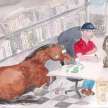Stirling Moss's Book of Motor Sport
It may look tatty on the outside but inside there is a mine of motoring history

I came across this book in our local book bank and couldn't resist bringing it home. My plan was to have a look through it and then return it to whence it came. That was nearly a year ago. Every time I think "It must go back" I flick through its aged pages and find another reason, or as my wife would say 'an excuse', to keep it for just a bit longer.
It was published in 1955 at a cost to enthusiasts of ten shillings and sixpence which in Britain's decimalised currency is fifty two and a half pence. Quite a lot for an average working man to pay for a Christmas or birthday present for a son when his wages were little over £9 per week.
There are loads of photographs dating back to the very earliest days of motor racing which started almost as soon as the first cars were sold over 120 years ago. Several of the pictures track the author's career from his first hill climb competitions through to his F1 exploits and endurance racing. It is amazing looking at these pictures what lack of regard there was for safety, not only for the drivers but for officials, pit crews and spectators. There was so little regard for safety that in 1955 at Le Mans there was the most horrendous crash near the pit lane that resulted in one driver being killed along with 81 spectators and over 120 injuries. Despite this carnage the officials decided the race should continue. The results that year were pyrrhic for motorsport and the following year the authorities began to implement improved safety standards but drivers still continued to pay the ultimate price.

Stirling Moss (1929 - 2020) was a British racing driver who has been described as "the greatest driver never to have won the Championship". He competed in 529 races of which he won 212. During his time in F1 he finished 2nd in the Championship four times and 3rd three times. He drove for Mercedes-Benz, Vanwall, Maserati and Cooper-Lotus. Evidence of his range of driving skills can be found in the tire tracks he left around Nürburgring and Le Mans which were and still are two of the most gruelling endurance races in motorsport.
As an authority on motor sport it is quite safe to say that he knew his stuff.
For anyone wanting to be a racing driver today Moss seven qualities that he would be looking for in anyone coming to him hoping for a career. They are:
1. A feeling for balance
2. Smoothness on the road
3. Relaxation in the driving seat
4. A sense of urgency
5. Forcefulness but with level headed safety
6. Quick reactions
7, A practical mind
I am sure those qualities defined back in the 1950's and in spite of all the technical advances that motorsport has achieved since then still apply today for teams like Williams, Ferrari and Red Bull.
One of the earliest references t motorsport talks about a "1,000 mile trial" which took place in 1900. That was, according to some records, only 14 years after the first patent for a motor car was filed by Karl Benz who became the Benz in Mercedes Benz. The trial took competitors around Britain in a series 0f nearly seventy stages starting in London but going a far north as Edinburgh and finishing back in London on 12th May 1900.

This "1000 Mile Trial" held in 1900 holds a particular fascination. Sadly there is scant narration about this event so it will be a subject for further research.
Motor racing in any format is dangerous. And just how cavalier attitudes to safety the sport was has already been mentioned with reference to the 1955 Le Mans 24 Hour Race. A strong taste of that danger can be gleaned from a collage of nine of Moss's favourite drivers who were men he had encountered on the circuit.
These drivers wore cotton suits which were not fireproof and their hats were made from the thinnest shells of cork possible. Driver safety was not paramount in the quest to be the fastest, to be the best and to win.

Of these nine drivers four of them managed to survive their exploits on the circuits. They are Karl King, Juan Fangio, Maurice Trintignant and Prince Bira. Mike Hawthorn outlived his career in racing but tragically died in a motor accident soon after retiring from the sport. Those who paid the ultimate price were Jean Behra, Ken Wharton, Peter Collins and Harry Schell all lost their lives while competing.
Thankfully all aspects of motorsport are now tightly regulated including the safety of everyone involved. Technology has brought about huge changes to car design making them more like cocoons for the drivers rather than high octane widow makers.
Somehow I don't think this book will ever be going back to the book bank.
About the Creator
Alan Russell
When you read my words they may not be perfect but I hope they:
1. Engage you
2. Entertain you
3. At least make you smile (Omar's Diaries) or
4. Think about this crazy world we live in and
5. Never accept anything at face value






Comments
There are no comments for this story
Be the first to respond and start the conversation.